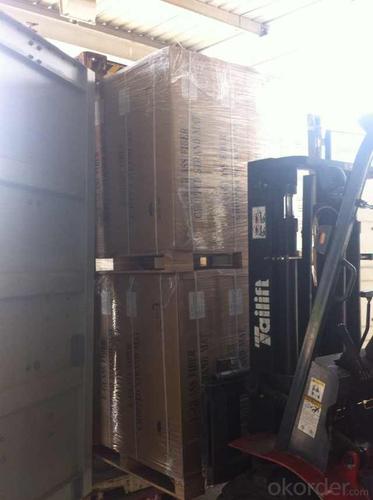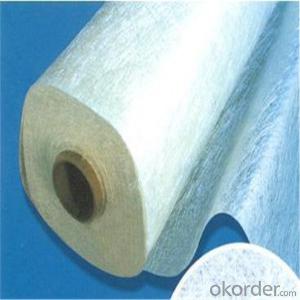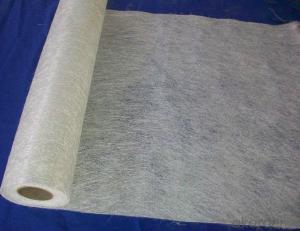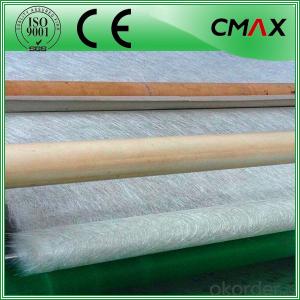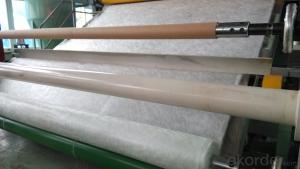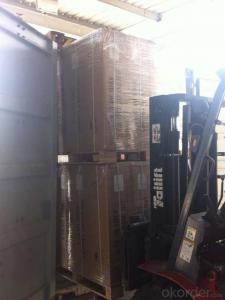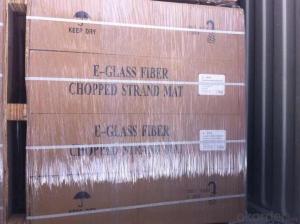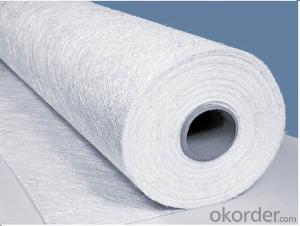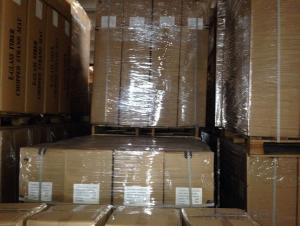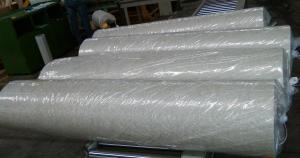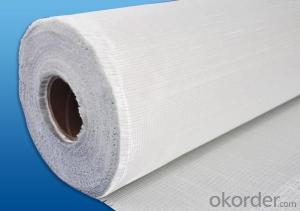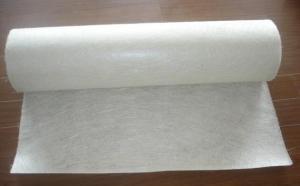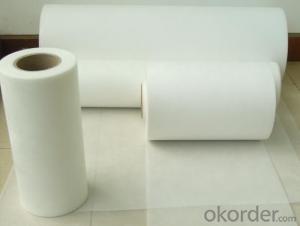Fiberglass Mat Tissue E Glass Fiber Chopped Strand Mat (Emulsion)
- Loading Port:
- China Main Port
- Payment Terms:
- TT or LC
- Min Order Qty:
- 20000 kg
- Supply Capability:
- 200000Kg Per Month kg/month
OKorder Service Pledge
OKorder Financial Service
You Might Also Like
1.Brief Introduction
E-Glass Emulsion Chopped Strand Mat is made of randomly distributed chopped strands held tighter by a emulsion binder. It is compatible with UP, VE, EP resins.
It is compatible with UP, VE, EP, PF resins.
The roll width ranges from 50mm to 3300mm.
Additional demands on wet-out and decomposition time may be available upon request.
It is designed for use in hand lay-up, filament winding, compression molding and continuous laminating processes. Its end-use applications include boats, bath equipment, automotive parts, chemical corrosion resistant pipes, tanks, cooling towers and building components
Fast breakdown in styrene
High tensile strength, allowing for use in hand lay-up process to produce large-area parts
Good wet-through and fast wet-out in resins, rapid air lease
3.Product Specifications
Property | Area Weight | Moisture Content | Size Content | Breakage Strength | Width |
(%) | (%) | (%) | (N) | (mm) | |
Mathods | IS03374 | ISO3344 | ISO1887 | ISO3342 | |
EMC80E | ±7.5 | ≤0.20 | 8-12 | ≥40 | 50-3300 |
EMC100E | ≥40 | ||||
EMC120E | ≥50 | ||||
EMC150E | 4-8 | ≥50 | |||
EMC180E | ≥60 | ||||
EMC200E | ≥60 | ||||
EMC225E | ≥60 | ||||
EMC300E | 3-4 | ≥90 | |||
EMC450E | ≥120 | ||||
EMC600E | ≥150 | ||||
EMC900E | ≥200 |
4.FAQ
Packaging:
Each Chopped Strand Mat is wound onto a paper tube which has an inside diameter of 76mm and the mat roll has a diameter of 275mm. The mat roll is wrapped up with plastic film,and then packed in a cardboard box or wrapped up with kraft paper. The rolls can be vertically or horizontally placed. For transportation, the rolls can be loaded into a cantainer directly or on pallets.
Storage:
Unless otherwise specified, Chopped Strand Mat should be stored in a dry, cool and rain-proof area. It is recommended that the room temperature and humidity should be always maintained at 15℃~35℃ and 35%~65% respectively.
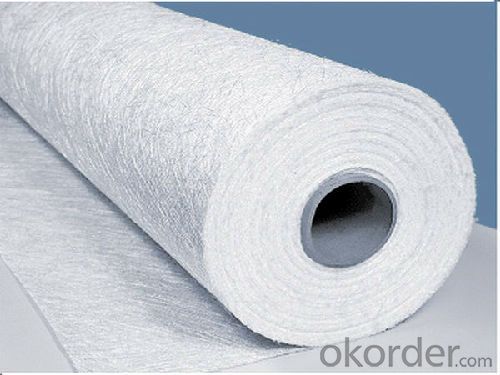
- Q: How does fiberglass mat tissue perform in terms of air permeability?
- Fiberglass mat tissue is characterized by its low air permeability. Its tight weave and construction, using fiberglass strands, result in less porosity, thereby allowing minimal airflow. This quality renders fiberglass mat tissue appropriate for situations that require minimal air permeability, such as insulation or filtration systems. By limiting the flow of air, fiberglass mat tissue enhances thermal insulation and enhances filtration efficiency.
- Q: Is fiberglass mat tissue suitable for wastewater treatment applications?
- Fiberglass mat tissue is indeed suitable for wastewater treatment applications. This material exhibits resistance to chemicals, corrosion, and degradation, rendering it a prime option for a range of industrial uses, including wastewater treatment. Its versatility allows for its utilization as filtration media, effectively separating solid particles from wastewater. It can also serve as a lining material, preventing corrosion in tanks and pipes, as well as reinforcing concrete structures employed in wastewater treatment plants. Moreover, fiberglass mat tissue boasts exceptional mechanical strength, dimensional stability, and thermal resistance, further bolstering its suitability for wastewater treatment purposes. Overall, this material proves itself as a dependable and efficient choice for employment in wastewater treatment procedures.
- Q: Does fiberglass mat tissue require any special precautions during storage?
- Yes, fiberglass mat tissue does require special precautions during storage. It should be stored in a dry and well-ventilated area to prevent moisture damage. Additionally, it should be kept away from direct sunlight and extreme temperatures as they can degrade the material. Proper stacking and support should also be ensured to prevent any deformation or damage.
- Q: Can fiberglass mat tissue be used for making fiberglass molds?
- Yes, fiberglass mat tissue can be used for making fiberglass molds. Fiberglass mat tissue is a lightweight material made from randomly oriented fiberglass strands. It is commonly used in composite manufacturing to provide additional strength and reinforcement to fiberglass laminates. When making fiberglass molds, the mat tissue can be used as a surface layer to create a smooth and durable finish. It helps to prevent air bubbles, improve the overall strength of the mold, and provide a good surface for the application of release agents or gel coats. However, it is important to note that fiberglass mat tissue alone may not be sufficient to create a rigid and durable mold. It is often used in combination with other fiberglass materials, such as chopped strand mat or woven roving, to provide additional strength and thickness to the mold. Overall, fiberglass mat tissue can be a useful component in making fiberglass molds, but it is typically used in conjunction with other materials to achieve the desired properties.
- Q: Is fiberglass mat tissue resistant to moisture vapor transmission?
- Yes, fiberglass mat tissue is resistant to moisture vapor transmission. It is a highly durable and moisture-resistant material that is commonly used in various applications where moisture control is important, such as in roofing, insulation, and flooring. The fiberglass mat tissue is specifically designed to prevent the transmission of moisture vapor, helping to maintain the integrity and performance of the materials it is used with. Its resistance to moisture vapor transmission makes it an ideal choice for environments where moisture control is critical.
- Q: Can fiberglass mat tissue be used for reinforcement in composites?
- Yes, fiberglass mat tissue can be used for reinforcement in composites. Fiberglass mat tissue is a non-woven material made up of randomly oriented glass fibers. It is commonly used as a reinforcement material in composite manufacturing processes. The mat tissue is often combined with resin to create a strong and durable composite material. The random orientation of the fibers provides multidirectional strength and reinforcement to the composite structure. Additionally, the mat tissue can be easily layered and molded into complex shapes, making it a versatile choice for various applications in industries such as automotive, aerospace, construction, and marine. Overall, fiberglass mat tissue is an effective and widely used reinforcement material in composites.
- Q: Is fiberglass mat tissue water-resistant?
- Indeed, fiberglass mat tissue exhibits water resistance. Fiberglass, a substance comprised of delicate glass fibers intricately woven into a mat, undergoes a process of being layered with a water-resistant substance, such as a resin or gel coat, in order to heighten its ability to repel water. The water-resistant coating acts as a barrier, preventing water from infiltrating the fiberglass mat, rendering it suitable for a wide range of applications that entail contact with water or moisture, such as the construction of boat hulls, shower stalls, and outdoor furniture. However, it is crucial to acknowledge that although fiberglass mat tissue possesses water resistance, it does not possess complete waterproofness. If not properly maintained or exposed to prolonged and excessive moisture, it may still absorb limited amounts of water over time.
- Q: How does fiberglass mat tissue contribute to the strength and durability of composite materials?
- Fiberglass mat tissue plays a crucial role in enhancing the strength and durability of composite materials. Firstly, the mat tissue acts as a reinforcement component by providing additional strength and rigidity to the composite structure. The fibers within the mat tissue are typically made of glass, which has high tensile strength and stiffness. These fibers are randomly oriented, creating a three-dimensional network that distributes and transfers stress throughout the composite material. This network of fibers helps to resist cracks and fractures, thereby increasing the overall strength of the composite. Furthermore, the mat tissue also acts as a barrier against delamination, which is a common issue in composite materials. Delamination refers to the separation of layers within the composite, which can weaken its structural integrity. The fiberglass mat tissue prevents delamination by bonding the layers together and improving the adhesion between them. This increased adhesion reduces the likelihood of interface failure and enhances the overall durability of the composite material. Moreover, fiberglass mat tissue helps to improve the impact resistance of composite materials. The random fiber orientation within the mat tissue creates a crisscross pattern, which enhances the composite's ability to absorb and distribute impact energy. This characteristic makes the material less prone to damage from external forces, such as impacts, vibrations, or mechanical stress. In summary, fiberglass mat tissue significantly contributes to the strength and durability of composite materials through reinforcement, delamination prevention, and enhanced impact resistance. Its unique characteristics and properties make it an essential component in various industries, including automotive, aerospace, construction, and marine, where the need for strong and durable materials is crucial.
- Q: Is fiberglass mat tissue suitable for automotive interiors?
- Automotive interiors can benefit from the use of fiberglass mat tissue. This versatile material is widely utilized in many industries, including automotive manufacturing. It possesses several advantages that make it appropriate for car interiors. To begin with, fiberglass mat tissue offers excellent insulation capabilities. It effectively reduces noise, vibration, and harshness (NVH) levels inside the vehicle cabin. This greatly enhances passenger comfort and the overall driving experience. Moreover, fiberglass mat tissue is lightweight and flexible, making it easy to install in different areas of the car's interior. It can be molded and shaped to fit various components like door panels, headliners, trunk liners, and floor carpets. Its flexibility also allows for seamless integration with other materials, such as sound-deadening substances, to further improve insulation and minimize vibrations. Additionally, fiberglass mat tissue exhibits resistance to heat, moisture, and chemicals commonly found in automotive environments. This renders it a durable and long-lasting material capable of withstanding the unique conditions inside a vehicle. It also resists the growth of mold and mildew, ensuring a clean and hygienic interior. Furthermore, fiberglass mat tissue can be easily coated or laminated with other materials to enhance its aesthetic appeal. It can be finished with various fabrics, vinyl, or leather to match the desired interior design and provide a luxurious feel. In conclusion, fiberglass mat tissue is a suitable material for automotive interiors due to its insulation properties, lightweight and flexible nature, durability, resistance to heat and moisture, and potential for aesthetic enhancements. Its utilization contributes to the creation of a comfortable, quiet, and visually pleasing cabin space for vehicle occupants.
- Q: Does fiberglass mat tissue require any surface preparation before application?
- Yes, fiberglass mat tissue typically requires some surface preparation before application. This is to ensure proper adhesion and bonding between the fiberglass mat tissue and the surface it is being applied to. The exact surface preparation required may vary depending on the specific application and the condition of the surface. However, some common steps in surface preparation for fiberglass mat tissue include cleaning the surface to remove any dirt, grease, or other contaminants, sanding or roughening the surface to create a better bonding surface, and applying a primer or other bonding agent if necessary. It is important to carefully follow the manufacturer's instructions and recommendations for surface preparation to ensure the best results and optimal performance of the fiberglass mat tissue.
Send your message to us
Fiberglass Mat Tissue E Glass Fiber Chopped Strand Mat (Emulsion)
- Loading Port:
- China Main Port
- Payment Terms:
- TT or LC
- Min Order Qty:
- 20000 kg
- Supply Capability:
- 200000Kg Per Month kg/month
OKorder Service Pledge
OKorder Financial Service
Similar products
Hot products
Hot Searches
Related keywords



